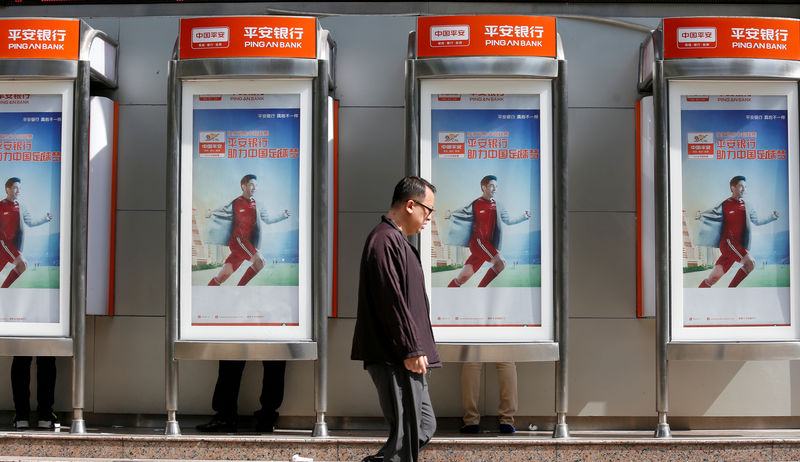 © Reuters. FILE PHOTO: A man walks past ATM booths of Ping An Bank in Shenzhen
© Reuters. FILE PHOTO: A man walks past ATM booths of Ping An Bank in ShenzhenBy Kevin Yao
BEIJING (Reuters) – China’s banks made the most new loans on record in January as policymakers try to jumpstart sluggish investment and prevent a sharper slowdown in the world’s second-largest economy.
Chinese banks tend to front-load loans early in the year to get higher-quality customers and win market share. But they have also faced months of pressure from regulators to step up lending, particularly to cash-starved private firms.
Banks extended a record 3.23 trillion yuan ($476.87 billion) in net new yuan loans in January, sharply more than expected and eclipsing the last high of 2.9 trillion yuan in January 2018.
Analysts polled by Reuters had predicted new yuan loans of 2.8 trillion yuan last month, up from 1.08 trillion yuan of new loans in December.
“While we wouldn’t pin too much on a single month’s data, the latest pick-up in credit could be a sign that credit growth is starting to bottom out in response to monetary policy easing,” Julian Evans-Pritchard, senior China economist at Capital Economics, said in a note.
“A recovery in lending, if sustained in the coming months, would be consistent with our expectation for (China’s economic) growth to stabilize in the second half of this year,” he said, noting there it usually takes six to nine months before new loans spur more business activity.
Sources told Reuters last week that the central bank had urged some banks to moderate their pace of lending in January to manage the amount of money flowing into the economy, spurring talk that the tally was even more robust than first thought.
Demand for credit picked up sharply in the corporate sector, followed by the household sector, according to data released by the People’s Bank of China (PBOC) on Friday.
Corporate loans jumped to 2.58 trillion yuan from 473.3 billion yuan in December, while household loans rose to 989.8 billion yuan from 450.4 billion yuan, according to Reuters calculations based on the PBOC data.
Corporate loans accounted for 80 percent of new loans in January, up sharply from 44 percent in December.
That will be welcome news for policymakers, who have been struggling to get money to struggling smaller firms.
While the PBOC has been pushing ample funds into the financial system, the money has not been flowing smoothly into the economy and generating activity.
Banks have been wary of lending to struggling smaller firms with higher credit risks, while businesses are reluctant to take on more debt when sales and profits are weakening
Several other key credit gauges also picked up modestly in response to the PBOC’s recent shift to policy easing.
Broad M2 money supply grew 8.4 percent in January from a year earlier, also beating forecasts.
Analysts had expected M2 growth to rise 8.2 percent for the month, compared with 8.1 percent in December.
Outstanding yuan loans grew 13.4 percent from a year earlier, above expectations of 13.1 percent but easing from December’s rise of 13.5 percent.
Growth of outstanding total social financing (TSF), a broad measure of credit and liquidity in the economy, picked up to 10.4 percent from a record low of 9.8 percent in December.
TSF includes off-balance sheet forms of financing that exist outside the conventional bank lending system, such as initial public offerings, loans from trust companies and bond sales.
TSF hit a record 4.64 trillion yuan in January, also far more than expected.
Analysts polled by Reuters had predicted the gauge would rise to 3.25 trillion yuan from 1.59 trillion yuan in December.
TSF can provide some clues on activity in China’s vast and unregulated shadow banking sector, which authorities have been targeting in a campaign to reduce systemic financial risks.
MORE GROWTH BOOSTING MEASURES EXPECTED
Banks extended a record 16.17 trillion yuan in new loans in 2018, while the central bank cut the amount of cash that they are required to keep as reserves four times to free up more funds for lending.
The PBOC again slashed the reserve requirement ratio (RRR) for banks in January by 100 basis points (bps), and analysts expect at least another 150 bps of cuts by year-end.
The central bank also has been guiding money market interest rates lower to reduce financing costs and coax banks to lend. But analysts at JP Morgan said in a recent note that banks have kept their average lending rates relatively steady.
Several bankers told Reuters they are keen to avoid repeating excessive and riskier lending that followed Beijing’s massive stimulus package during the global financial crisis. Commercial banks’ non-performing loan ratio climbed to a 10-year high in 2018 and corporate bond defaults hit a record.
Banks would rather use the liquidity freed up by RRR cuts to buy “bonds at any cost” than to give out loans, said one bank executive at the financial markets department of a joint-stock bank.
China’s state council said on Thursday it aims to cut private firms’ financing costs to reasonable and stable levels and improve their ability to raise funds through various measures including issuing bonds. Private firms, with limited collateral, are considered riskier than state-backed firms.
Source: Investing.com




























